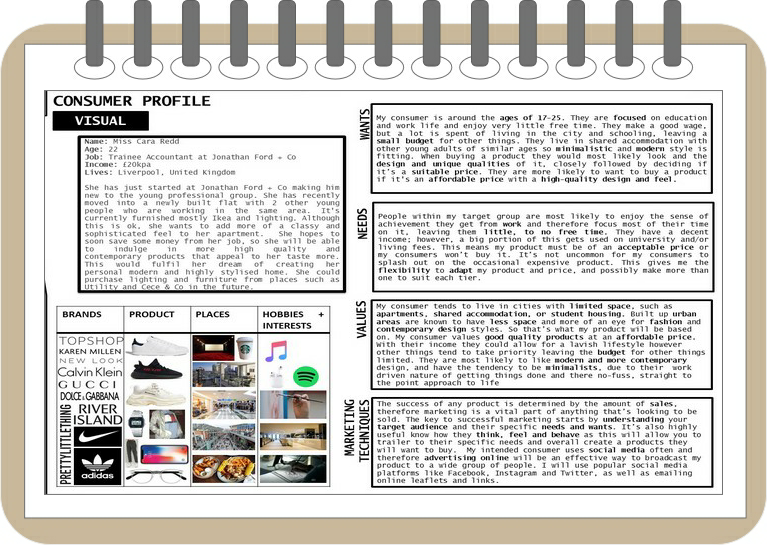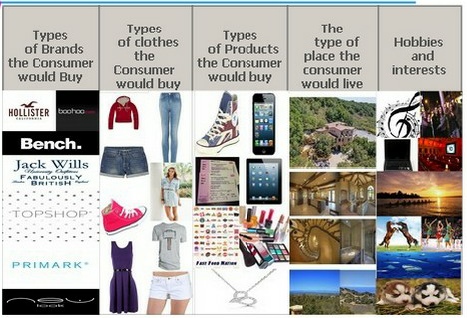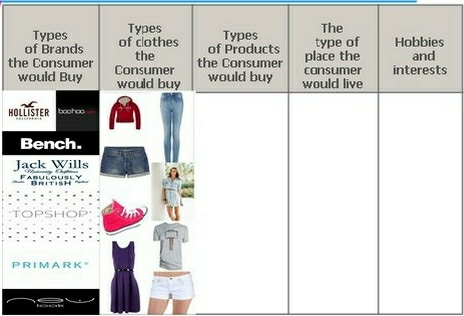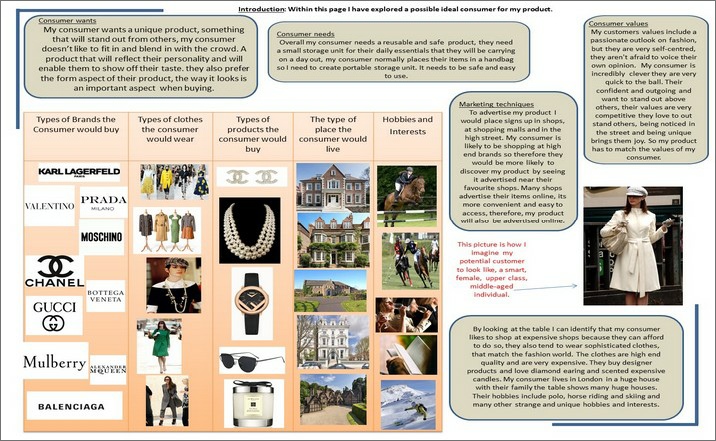





Copyright © 2020 M.Kenny, A.McGuire and E.Jones. All Rights Reserved
No parts of this website maybe copied or reproduced without permission









An example of how to layout the consumer profile sheets in your sketchbook are shown
below. Remember you can use your own headings relevant to your own project. This
shows one of the possible ways of how you can layout your sheet if you need help
and guidance. How you lay this page out is again up to you, there are several ways.
Hover over the sections for more guidance
Consumers can be identified by many different preference, lifestyle, life stage,
attribute, and trait categories. Thinking about consumers in terms of the way they
are represented by categorical tiers can be useful. This can be shown as a mind-map
or a top down mind-map…….
Sketchbook: Consumer Profile
A consumer profile is a way of describing a consumer categorically such as their behaviour, location, habits and so on which is important in targeting specific markets and for advertisement purposes. The techniques now used to gather such information are very sophisticated and demonstrate the importance of the knowledge-driven economy.

- Successful marketing starts by knowing who your customers are and what they need
and desire.
- In other words understanding how they think, feel and behave.
- There is no point wasting valuable time and money marketing your product to people
who aren’t interested in what you are selling.
- Watch the video about a revolutionary electric car that a famous designer of the
time released. Why did it fail?




























How:
- How do your consumers shop?
- How do your consumers find out about products, holidays etc
- How do your consumers socialise?
Where:
- Where do your consumers buy their food?
- Where do your consumers buy their clothes?
- Where do your consumers socialise
- Where do your consumers research information?
- Where do your consumers go on holiday?
- Where do your consumers live?
What:
- What do your consumers read?
- What electronic devices do they use?
- What do they use the Internet for?
- What social media programs do they use?
- What car to they drive?
Behaviour:
- Describe what TV programs they watch?
- Describe what hobbies they have?
- Describe what attracts them to a car?
- Describe what technology they like using?
- Describe what newspapers they read?
- Describe what articles they read?
Demographics:
- Describe their age, gender, income, etc.
- Describe their occupation, shopping habits,
- Describe their hobbies.
Psychographics:
- Age
- Background
- There every day traits
- Love & Hate
- Any other Appropriate Headings







TASK 2: Visual Profile
Collect images related to your consumer
|
●
|
Set up a table and collect images that help to profile your consumer.
|
|
●
|
This is an effective method of collecting useful information quickly
|
|
●
|
You can add your own headings to the table below….
|







|
Types
of Brands the Consumer would Buy
|
Types
of clothes the Consumer
would buy
|
Types
of Products the Consumer would buy
|
The
type of place the consumer would live
|
Hobbies
and interests
|
|
|
|
|
|
|

TASK 3: Demographics
Demographics is how you would describe your customer in terms of age, where they live, gender, race, household size, income, occupation, education and country of birth.
There are websites including government websites that are good sources of information to find out more about the demographics of the customers.

Customise your Table:
- Try to set up your own headings that are suitable for your consumers characteristics
and your task.
- Other examples could include:
- Favourite subjects in school.
- Favourite type of holiday.
- Type of music they listen to.

For example, the demographics of a customer who buys VW golf GTI may be male, age
30- 45 years, white collar occupation, household income greater than 30,000 with
children and targeting middle class, as well as the wealthier working class. Its
high price makes the new Golf also target the upper middle class. The consumer will
typically live in a three to four bedroom detached house. Golf’s five-door model
accounts for 70 per cent of all GTI sales and the steering as been adjusted on the
latest model so it can be set in comfort mode so that the Golf is smoothed out on
bumpy access roads. This shows it is aimed as a family car not at the boy racer so
to speak. Compare this to the consumer profile of someone who buys the Ford Focus
ST a very similar car.











TASK 4: Persona
A persona is how you would describe your customers in terms of:
|
●
|
Interests – the key social interests your customers engage in e.g. Golf
|
|
●
|
General personality – the personality characteristics of your customers e.g. Conservative
|
|
●
|
Where they “hang out” – what places on and offline do they network, socialize etc.
|
If you know your customer you can target specific marketing strategies, promotional activities, sales drives and communication messages to your consumer. For example would the over 60’s generation use Internet, Facebook, Twitter and You tube advertising compared to someone in their late teens, early twenty’s?
Use the data you have collected and create an “imaginary” character or persona
The information that you have gathered should give you clear understanding of the general nature and characteristics of your typical intended consumer.
Use that character to outline the characteristics of the user and their needs and wants in relation to your design problem.
TASK 5:: Conclusion (Needs and Wants)
You should now have a clear picture of the type of customers your product should
be targeting. Creating a strategy with these ideal customers in mind will help you
avoid wasting time and resources on unsuccessful marketing efforts. Through focused
and more consistent marketing communications, What are their needs and wants?
list all the qualities that you think the intended user may want from your product;
list all the qualities that you think the intended user may need from your product;
how will you market your product to maximise your audience?











Demographics:
My consumer is a young adult of around 16-30 years of age, this person will most
likely still be in education and will travel by car or public transport to and from
school. I think that my consumer will be education-oriented but will still enjoy
recreational activities outside of school time.
The young adult could be any gender as I feel like this product is unisex and applies
to most people, the consumer might enjoy shopping and style related things. Because
the product will be made to be sold in a design museum, the consumer will have to
have some interest in design and different eras of history. However, I also think
that this product will be appealing and interesting for someone who doesn’t know
much about this specific era of design and that they might buy it simply because
they think it looks good.
This age consumer might not have a lot of money to spend on furnishings like this,
especially if they attend university. For this reason, I want to make sure that my
product will be affordably priced.
Demographics:
Age: 16 - 25
Gender: Product should be suitable for both genders
Personality: Introverted but enjoys the occasional night out with friends, can be
considered quite geeky or nerdy
Occupation: Potential low income part time job whilst
studying at university or potentially just entering their first full time job
Residence: Student accommodation, shared flats or apartments
Cost limitations: Due to the high costs of university and low income salary they
may not be able to afford a high end
expensive product
Preferred brands: Netflix, Samsung, Apple, Xbox, Outfit, Nike
Hobbies and interests: Marvel, Comics, Movies and TV, Video, Games, computer games
Consumer Profile:
My product will be aimed at young adults between the age range of 25 – 30, who are
renting or purchasing their first home. Home is likely to be located in the city
or suburbs of a city, possible in apartment building high rise flats, which appeal
to this target market of first-time buyers or renters. These have moved out of the
family home and are setting up first time.
They are out of education, and working in full time jobs, so have a reasonable income
to spend on products for the home. The target market are unlikely to have gardens,
as traditional houses in the country; but may have balconies, window boxes or rooftop
gardens. This group will be environmentally conscious, with a definitive interest
in purchasing items for themselves that are kind to the planet and will benefit the
natural world.
They are not mainstream shoppers, preferring to frequent vintage markets, boutiques
and charity shops. They believe in social change in small amounts, have green political
views, alternative lifestyles and mare typically interested in veganism, craft beers,
independent retailers and keen to support original design, with a positive outlook
on recycling and living a sustainable life. The product should appeal to both males
and females, to attract a wider target market. They will be socially aware; they
shop in boutiques, spend leisure time browsing, visiting artisan coffee outlets and
are very social media aware. They will be using applications such as Pinterest and
Etsy, where individual designers and craftspeople make and sell one-off original
products



Consumer Profile (Persona)
Produce a number of headings that you can use to describe the persona.
Write a description of the persona under each heading as if that persona had written
it themselves:
- Age
- Background
- There every day traits
- Love & Hate
- Any other Appropriate Headings
Give your character a name, be sensible.
“Hi my name is Joshua and I am 11 years old. I love to play outside making my tree
house or with my favourite bike is a “mountain Bike.”
The description of your imaginary character should be a description of who your "typical“
intended consumer is. Use the list below to help you build up your persona.

























































































